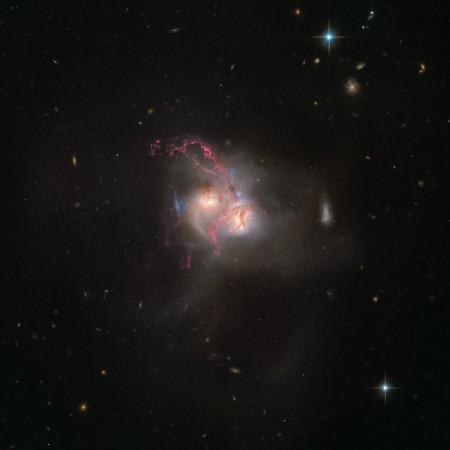
An amazing new image of the galaxy NGC 5256 has been captured by the Hubble Space Telescope. The image portrays the cosmic body emitting colour and light, the European Space Agency (ESA) has revealed.
ALSO READ: Here's why you shouldn't gift sex to your partner this Christmas, according to a sexologist
NGC 5256's unique shape and colours point towards it being a merger of two galaxies. This galaxy is located 350 million light years away from Earth in the constellation of Ursa Major, which shelters the Big Dipper — a popular asterism which comprises of seven bright stars.
The hearts of the galaxies fusing in NGC 5256 are located at a distance of 13,000 light years apart.
ALSO READ: NASA plans to search for alien life in Alpha Centauri star system in 2069
"Interacting galaxies can be found throughout the universe, producing a variety of intricate structures. Some are quiet, with one galaxy nonchalantly absorbing another. Others are violent and chaotic," an ESA statement said.
Galaxy mergers are a violent kind of galaxy interaction, occuring when two or more galaxies collide. At times some galaxy mergers can cause supernovas or star explosions. These mergers also create quasars, which are active galactic nuclei of very high luminosity, and consist of supermassive black holes surrounded by orbiting accretion disks of gas.
ALSO READ: Here's the right age for men to freeze their sperm
Galaxy mergers like NGC 5256 used to be more common when the Universe was in its infancy. The signs of near-collisions and past mergers can be seen in most galaxies.
"Our own Milky Way too has a long history of interaction: it contains the debris of many smaller galaxies it has absorbed in the past; it is currently cannibalising the Sagittarius Dwarf Spheroidal Galaxy; and in a kind of cosmic payback, the Milky Way will merge with our neighbour, the Andromeda Galaxy in about two billion years," ESA stated.
ALSO READ: Do you know what 'Pussypedia' is?
New structures of gas and debris are produced from strong tidal effects between the merging galaxies. Stars are rarely seen colliding with each other as the distances between their galaxies are very large.
The two galaxies merging in NGC 5256 have an active nucleus where a supermassive black hole is eating up gas and dust.
ALSO READ: At $22 million a year, is Pentagon still hunting UFOs?
"Both of these nuclei — and the region of hot gas between them — have been heated by shock waves created as gas clouds collide at high velocities," NASA's Chandra X-ray Observatory has found, said ESA.
Another pair of interacting galaxies can be seen at a far off distance towards the right of NGC 5256. It is yet to be observed by astronomers.
ALSO READ: 'Sperm bandits' gangrape male hitchhiker in South Africa
NGC 5256 is also found to be situated a few degrees away from Messier 51, a popular pair of interacting galaxies that Hubble observed in 2005.








![India Auto Roundup: Maruti Suzuki, Mahindra have exciting launches in November [details here]](https://data1.ibtimes.co.in/en/full/805520/india-auto-roundup-maruti-suzuki-mahindra-have-exciting-launches-november-details-here.jpg?w=220&h=138)








